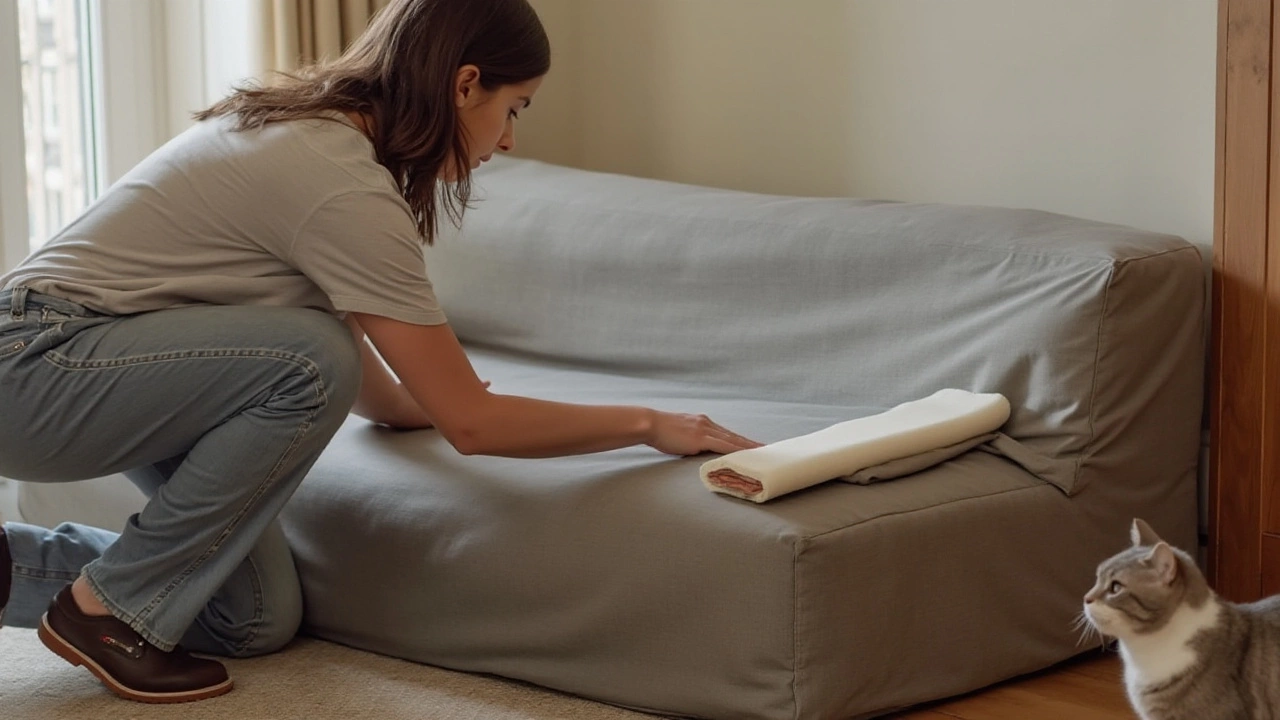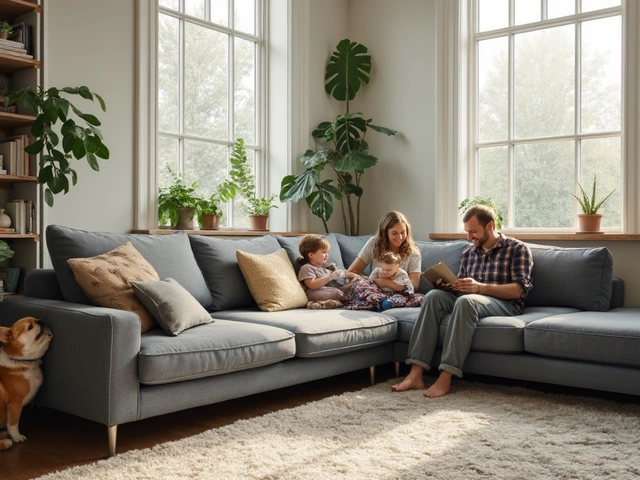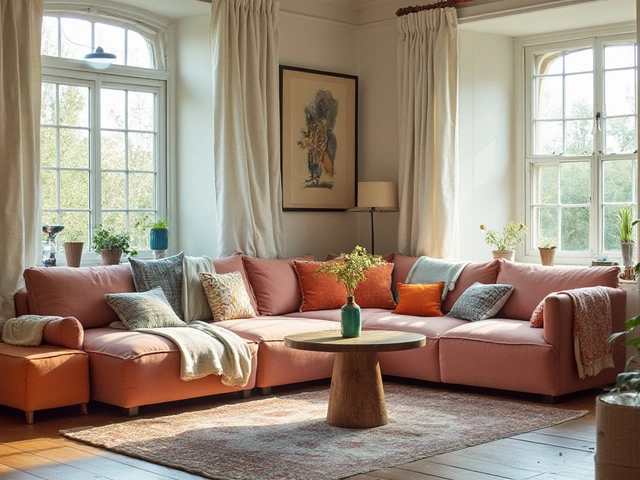 17
Nov,2024
17
Nov,2024
Storing furniture, especially bulky items like couches, can often feel like a game of Tetris where space is the ultimate prize. But before you decide to stand yours up to save room, it's vital to consider the potential implications and impacts on the structure and material of the furniture.
Couches are typically designed to rest on four legs, offering balanced support. Changing this natural orientation can impact the furniture's durability and appearance over time. But if space constraints leave no other option, there are ways to approach this safely.
While standing a couch upright might appear to be the ultimate space saver, understanding how to do this without compromising the couch’s integrity is key. Depending on the design, material, and environment where the couch will be stored, the strategy can vary. Read on to discover how best to navigate these tricky storage waters.
- Understanding Couch Design
- Potential Risks of Upright Storage
- Proper Techniques for Vertically Storing a Couch
- Alternative Space-Saving Ideas
Understanding Couch Design
When considering how to store a couch, it's essential to first delve into the intricacies of couch storage design. The typical couch isn't merely a piece of furniture; it's a carefully crafted amalgamation of style, comfort, and durability. Most couches sport a wooden frame, which offers a sturdy backbone while aiming for both strength and flexibility. Now, consider the padding, which is usually a mix of foam and fiber, ready to hug your form as you lounge across it. This composite can be delicate, though, and that’s where the need for proper storage methods begins to find justification.
The structural design of a couch is fundamentally intended to distribute weight evenly across its frame when placed in its intended position. This ensures longevity and maintains the integrity of its shape and comfort. When a couch is stored upright, this balance can be disrupted, which could lead to sagging or warping. According to furniture expert Karen Smith, "A couch standing on its end for extended periods may lead to deformation, particularly in the armrests and cushions, where gravity might cause filler materials to settle unevenly."
Yet, the concern isn't solely with the outer frame and stuffing. Upholstery—cotton, leather, microfiber, to name a few—plays a key role in how couches age. Exposure to environmental factors like dust or moisture during storage can affect material lifespan, especially if stored improperly. For instance, an upright couch packed tightly within storage may develop creases in its fabric, which can become permanent over time. Even the color may change due to uneven exposure to light or dampness. Leather can become particularly vulnerable, as uninterrupted supply of air is necessary to avoid cracking.
Interestingly, there are various designs that can influence how a couch should be stored. Sectionals, with their lock-in features, or loveseats, may have different storage advisories due to their unique builds. Despite their smaller stature, loveseats can be equally challenging due to less robust frames compared to larger couches. Furthermore, sofas with recliners contain mechanisms that, when stored incorrectly, may need re-alignment or lubrication before use again. This makes it imperative to consider the furniture care approach to each type.
Below is a table outlining a few common couch types and a brief on their respective storage advice:
| Type of Couch | Storage Advice |
|---|---|
| Standard 3-Seater | Keep horizontally when possible; protect frame and cushions |
| Sectional Sofas | Store each section separately; ensure tight locks are face-up |
| Loveseats | Use protective wrapping to safeguard upholstery |
| Leather Couches | Apply leather conditioner before storage to prevent drying |
Truly understanding the fundamentals of couch design helps not just in making informed storage decisions but, more crucially, extends the lifespan of the furniture by ensuring its structural fidelity and appearance for years to come. Clever planning and execution in terms of couch storage can save costly repairs or the disappointment of discovering a misshaped favorite piece of furniture upon retrieval.

Potential Risks of Upright Storage
When you decide to store your couch standing upright, the initial thought might be the sheer amount of floor space you can save. Yet, there's an array of potential risks couch storage enthusiasts should be wary of. One of the primary concerns is the strain placed on the frame and joints. Couches are designed with a structural integrity that relies on being evenly balanced across their whole framework when laid flat. When stored vertically, gravity shifts pressure points, which can introduce undue stress on parts not built to bear the weight. Over time, this can lead to warping, especially in wooden frames, and might loosen joints, resulting in an unsightly and potentially unsafe piece of furniture.
Another aspect to ponder is upholstery wear and tear. Gravity isn't just hard on the frame; it can also affect the furniture care for the fabric or leather covering. Prolonged upright storage can cause sagging or creasing in materials that aren't usually facing such angles. This can lead to permanent indentation marks or wrinkles, severely altering the couch's appearance. Additionally, environmental factors come into play. Dust, moisture levels, and even pests can affect an upward-standing couch differently than one placed horizontally. The top part of the couch, which usually doesn't deal with such wear, suddenly becomes a potential haven for dust or insect activity, notably if protective covers aren’t used.
Let's not overlook the possible risk to floors and ceilings. Since you’re placing a significant amount of weight vertically, there's a chance of forming pressure marks or scratches on the floor where the couch makes contact. This is especially true for sensitive flooring such as hardwood or laminate. As a clever tip, consider using furniture pads as a protective buffer between the couch’s contact points and the floor. On the ceiling front, certain vertical positions might pose issues if your space is tightly constrained, risking ceiling scuff marks if the couch isn’t measured and aligned correctly.
It's crucial to calculate accurately the height of the room against the size of the couch. Misjudgments here can lead to jamming the couch in an uncomfortable position, making retrieval later a problematic endeavor. Placement and extraction can also become more complex and physically demanding, posing injury risks if not done carefully. Taking these factors into account ensures you won’t face unwelcome surprises. As
Robert Sams, a renowned furniture conservation expert, once mentioned, “The longevity of any piece of furniture hinges not just on the quality of its materials, but on the way we choose to store it.”His words highlight the intricate balance between using space wisely and preserving the longevity of your furnishings.

Proper Techniques for Vertically Storing a Couch
Storing a couch in an upright position might seem straightforward, but it requires careful consideration to avoid damage. The first step is to thoroughly clean your couch. Dirt and grime that remain on the fabric can become embedded over time, especially when the furniture is stored in a new orientation. Use a vacuum with an upholstery attachment to remove loose debris and spot-clean any stains with an appropriate fabric cleaner. This ensures that any prolonged contact time with dirt is reduced, which can preserve the integrity of your couch’s material.
When ready to store, consider the surface area where the couch will rest. A flooring material like carpet may exert less pressure on the couch’s armrests or end panels compared to concrete or hardwood. You might want to place a protective barrier like a furniture pad or a piece of cardboard underneath these contact points. This can help distribute weight more evenly and prevent marks or dents over time. Remember that weight distribution is crucial in this storage method.
After preparation, it’s time to carefully move the couch to its standing position. If the couch is large or cumbersome, make sure to recruit some extra hands to help. Lifting with care, position the couch so that the weight is evenly balanced on two points—either armrest or backrest, depending on which is sturdier. Furniture care experts often suggest evaluating the frame of your couch to determine the best side to support the weight. A well-constructed frame will handle the balance without losing shape or strength.
Once in place, ensure the couch is secured. While upright, it’s vulnerable to tipping, so use straps or anchors if possible. Stability is essential, especially in storage spaces that might experience environmental changes like temperature shifts or humidity. A secure setup prevents sudden falls, which could damage both the couch and any nearby items. Keeping the sash strong and firm holds the couch in its place safely.
An interesting tip shared by long-time furniture retailer Jonathan Adler is to cover the couch with a breathable fabric or a specialized furniture cover.
“This protects against dust and accidental spills during the storage period while allowing air to circulate, ensuring that mildew and odors don't develop,” he notes.You never know what unexpected scenarios might arise that could affect your couch’s condition. With the right coverage, you can head off many storage-related damages before they happen.
Finally, remember to check on your stored couch occasionally, if feasible. This allows you to spot potential issues before they become significant concerns, like signs of wear in the areas contacting the ground or sagging that might indicate improper weight distribution. Occasional checks can ensure that when it's time to restore your couch to its place in the living room, it’s ready and waiting without need for any major refurbishing.

Alternative Space-Saving Ideas
When dealing with cramped spaces, storing furniture like couches requires a dash of ingenuity, much like solving a puzzle where each piece must fit seamlessly into the bigger picture. One classic approach is the creative use of multifunctional furniture. Imagine a couch that doubles as a storage unit. There are designs with built-in drawers underneath, perfect for tucking away blankets, books, or other living room essentials. This not only keeps clutter at bay but also maximizes the utility of your space. Let’s not forget the beauty of a modular sofa that can be rearranged to suit different configurations, fitting snugly wherever you need it to.
Another clever strategy is looking up... literally. Vertical space is an often-underutilized resource in most homes. By installing sturdy shelving units or cabinets above your eye level or using tall bookshelves, you can create room for storage while keeping valuable floor space open. The key is to balance between accessibility and efficiency, ensuring that the items you need most often are within reach and the ones less frequently used are stored higher. A well-equipped wall-mounted fold-out table can serve as a dining surface or a workstation, folding away into mere inches when not needed.
Furniture tips also include hanging items where possible. Wall hooks can accommodate everything from bicycles to musical instruments, keeping them off the ground. In the living room, hanging planters or art can inject personality into vertical real estate. Meanwhile, taking advantage of lofted beds or platforms can open up storage possibilities underneath, akin to a whole new room’s worth of capacity. Some savvy city dwellers even design mini lofts within their apartments to carve out extra storage or cozy reading nooks.
For those daring enough to reimagine their spaces, it's worth exploring collapsible and fold-away furniture, a concept revolutionized by tiny home enthusiasts. From folding chairs to expandable dining tables, the market is brimming with innovative designs. These pieces are lifesavers when hosting guests and can be discreetly tucked away, blending into the décor once not in use. As iconic furniture designer Bill Stumpf said, "Design is about optimizing function, not just aesthetics." Using pieces that morph to your needs without compromising comfort is a testament to this ethos.
Lastly, creating designated storage zones with stylish dividers or slipcovers can carve up open-plan spaces, providing hidden storage that’s both chic and functional. These zones can be customized with interior elements that reflect personal tastes, making the room feel larger and more inviting without sacrificing the utility. And if you're looking to thin out some furniture, selling unneeded pieces not only recoups some of your investment but also clears essential space. Reaching a balance between minimalism and necessity often provides clarity in tight quarters.
In constructing your living area's layout, trial and error play a significant role. Experimentation and adaptability can lead to a pleasantly surprising outcome. Whether it involves adjusting existing pieces or introducing novel ones, the possibilities are as vast as your creativity. Each of these solutions brings the potential to refresh your living space and enhance its functionality, ensuring everything has its place and that place invites a sense of calm and order.




